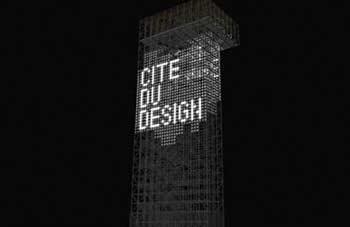What would you do in a small town if the coal mines closed, the bicycle, ribbon and weapons factories shuttered, and there was not much left to do but ride the tram back and forth from one end of town to the other? Most people would pack up and leave, but in Saint Etienne, France, they’ve got more gumption than that.
Taking a page from Mickey Rooney’s book, they put on a show. And not just any old show, mind you, but an international design biennale. Originally started by the enterprising local Beaux Arts college, this year the Biennale was housed for the first time in an abandoned weapons manufacturing complex, renamed “Cité du Design” for the occasion.
The least interesting hall in the Biennale was “Building i”, filled with a preponderance of shock art that has been done for so long as to be no longer shocking. The notable exception was in the DNA Eden exhibition – a sleeping lioness who literally melts into droplets of liquid gold – so convincingly done that by time I was able to see it, the golden drops were covered with fingerprints from people checking to see if the gold was really liquid.
The second hall, Cité Berthiez, had lots of work that was either thought provoking or beautiful, or both. Food was both a curated theme and an informal one in much of the work. In the “Good Food” exhibition, which was part laboratory, part performance art, and part café, visitors were invited to taste things like blue cheese and chocolate while breathing through a tube so their perceptions were not influenced by smell. Elsewhere, there were group exhibitions from Japan, Israel, Canada, Belgium and Morocco, and individual design work from Senegal and Nigeria. There were also student projects on display, focusing on collaboration with industry, and some car design thrown in for good measure.
The theme in the third exhibition hall “Fabrique 5000” (curated by Matali Crasset, the purported heir apparent to Philippe Starck), was a little unclear, but the work was so bizarrely wonderful that it really didn’t matter – an entire room filled with graters from different cultures and time periods, instruments to plant rows of alfalfa seeds in a cucumber to turn it into a chia pet, and a micro production line to vacuum form the goofy shape of your choice into discarded plastic phone cards. Walking through the hall, the important thing was not to ask “why” (we Americans are such a pragmatic bunch) but to honestly admit to yourself that you had forgotten that design could be fun.
The Biennale had a full roster of lectures and round table discussions with such varied topics as “International Strategies for Innovation” and “Sad Objects of Desire.” The most memorable talk I attended was given by Hervé This, the French chemist who created “Molecular Cuisine.” His presentation consisted of lots of wacky demos – making strange mixtures, popping them in the microwave and then having the audience taste them, all the while charmingly crusading for more innovative cooking through applying scientific techniques (like cooking eggs in sulfuric acid (entirely edible, we were assured)).
The Biennale doesn’t just stop there – the three museums and many galleries in town get in on the act with new commissioned work and new exhibitions (including a great Haute Couture exhibition at the Museum of Arts and Sciences with new dresses made entirely of ribbon by six French designers).
Links:
Cité du Design
"The Cité Du Design" was on view November 22 through December 3, 2006 in St. Etienne, France.
All images are courtesy of the Cité Du Design website.







